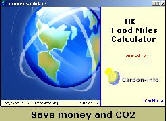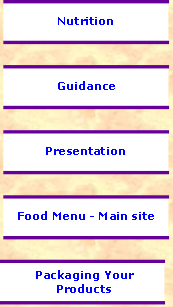















7th February 2007





There are FIVE basic groups into which food can be placed according to what we get from them. A balance of all these groups allows us to develop as fully as we can and means that we should know a little about what goes into products that we can buy in the shops. Whilst we can ‘get by’ on eating chocolate bars and fizzy drinks for a day or two, eating them and only them, for much longer and we might start finding we weren’t developing as well as we might!

energy and that we need energy to move, heat ourselves (with body heat) and to develop. The biggest group of energy providers are things like sugar, starches, cereals, porridge, oatmeal, cornflour, rice, fruit, bread, cake, potatoes, spaghetti, biscuits, etc. All of these can be converted easily into body fat. Looking at the list can you recognise that all of these are amongst the ‘staple’ sources of foods for different countries. Make up a list of countries and their ‘associated national foods’. Obviously some countries are able to grow some crops better that other places in the world and from those main ingredients
PROTEINS: Body building, growth and repair of damaged tissues are the major role of proteins although they can also be a source of energy and be converted to body fat if not used during activities. Meats that are lean, cheese, eggs, dairy products (milk) and a little from bread, beans and peas – these are all sources of proteins for our diet.
FATS: Another supply of energy comes from the group called ’fats’ and obviously if we don’t use up the chemical energy that is contained in them our bodies try to build up a ‘store’ for future use – just in case we run out of them in our diets – this means we store them as ’body-fat’.
VITAMINS: There are many different classes of vitamins and you will have heard of ones like Vitamin C, in fruit. Without vitamins many of our body processes cannot be done as well as they might. Building bones and strong teeth is one example you will certainly have heard of. In times when foods that contained vitamins weren’t available – such as on long early sea voyages – problems associated with deforming bones and poor teeth were well known. It became essential to visit islands to get fresh supplies of fruit and vegetables whenever possible. You can probably just go into the kitchen ! When vitamins were first identified they were classed into two groups – one called vitamin A – this was soluble in fat – and the other was vitamin B that was soluble in water. Other vitamins were found as time went by and these were labelled with other
CARBOHYDRATES: We have said that ‘Food is Fuel’ and is a store of chemical
letters – C, D, E and so on. You may have heard of B1, B2 etc – well this came about because the class of vitamins into just one group of B was too broad. There were actually many separate ones that were discovered later that were found to be soluble in water – hence the numbered vitamins in the B-group.
MINERALS: Minerals are things like Zinc, Iron, Magnesium, Calcium, etc. They are all minerals found in the world around us – not surprising that we need them for all the chemical processes that go on inside us! Iron is essential for our blood to be able to carry oxygen round the body – and without oxygen our muscles can’t work properly. If you have ever walked around at very high altitudes (where there is less oxygen in the atmosphere) you will know how breathless you can get. We get Iron from some green vegetables, liver, beef &lots of other sources. It is best eaten from different foods -some don’t let us absorb it quite so easily by just eating those foods.




